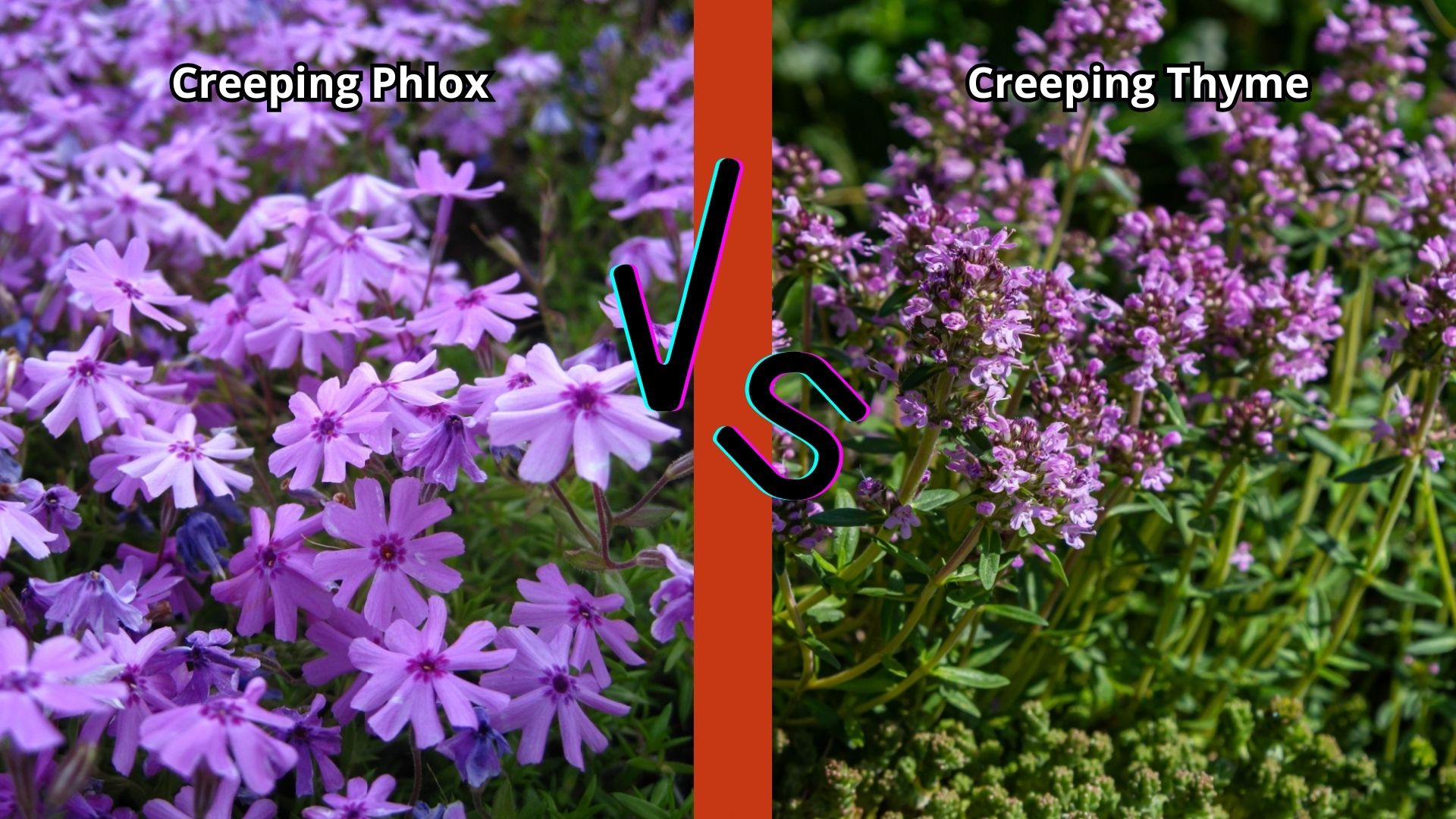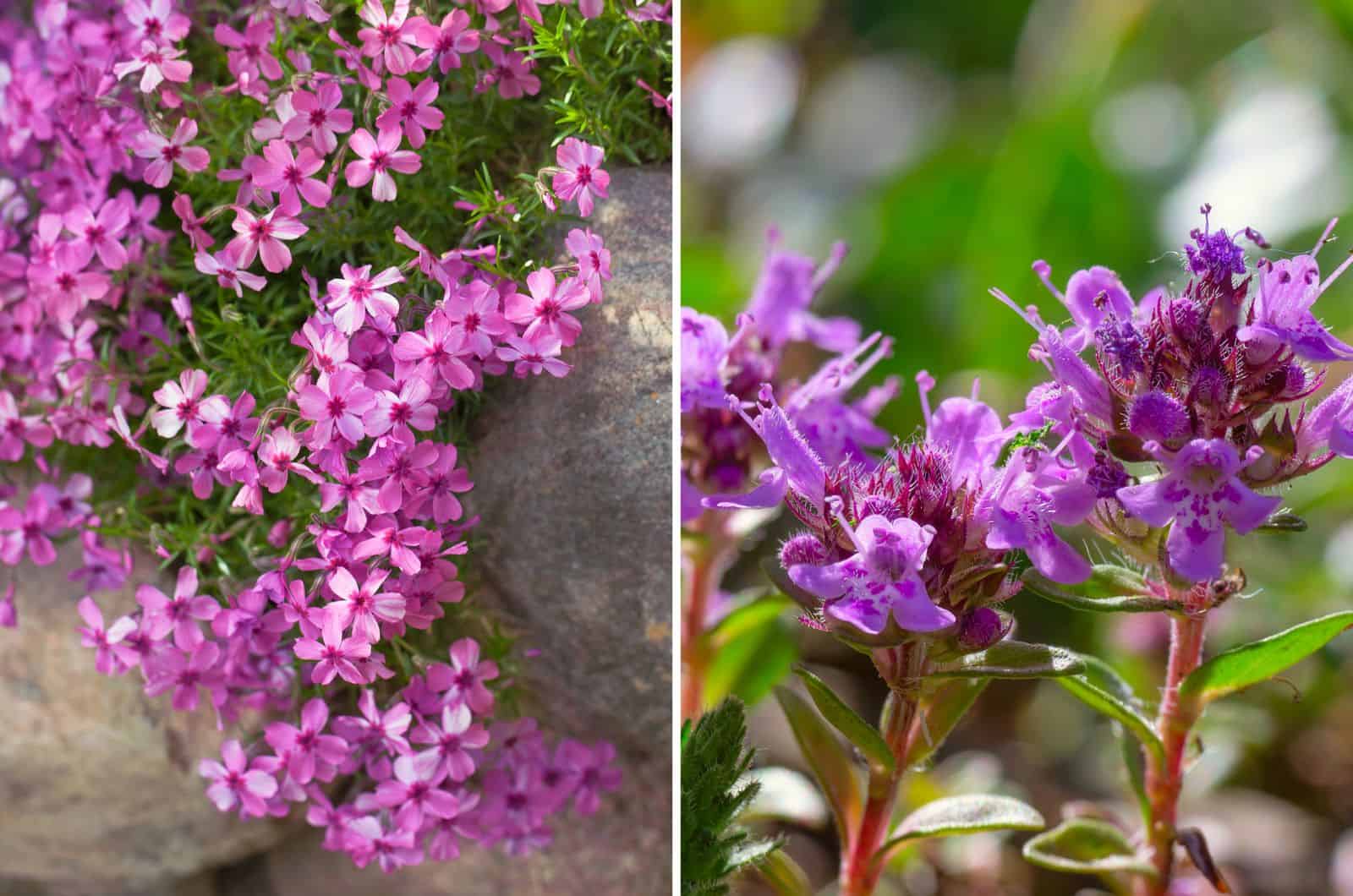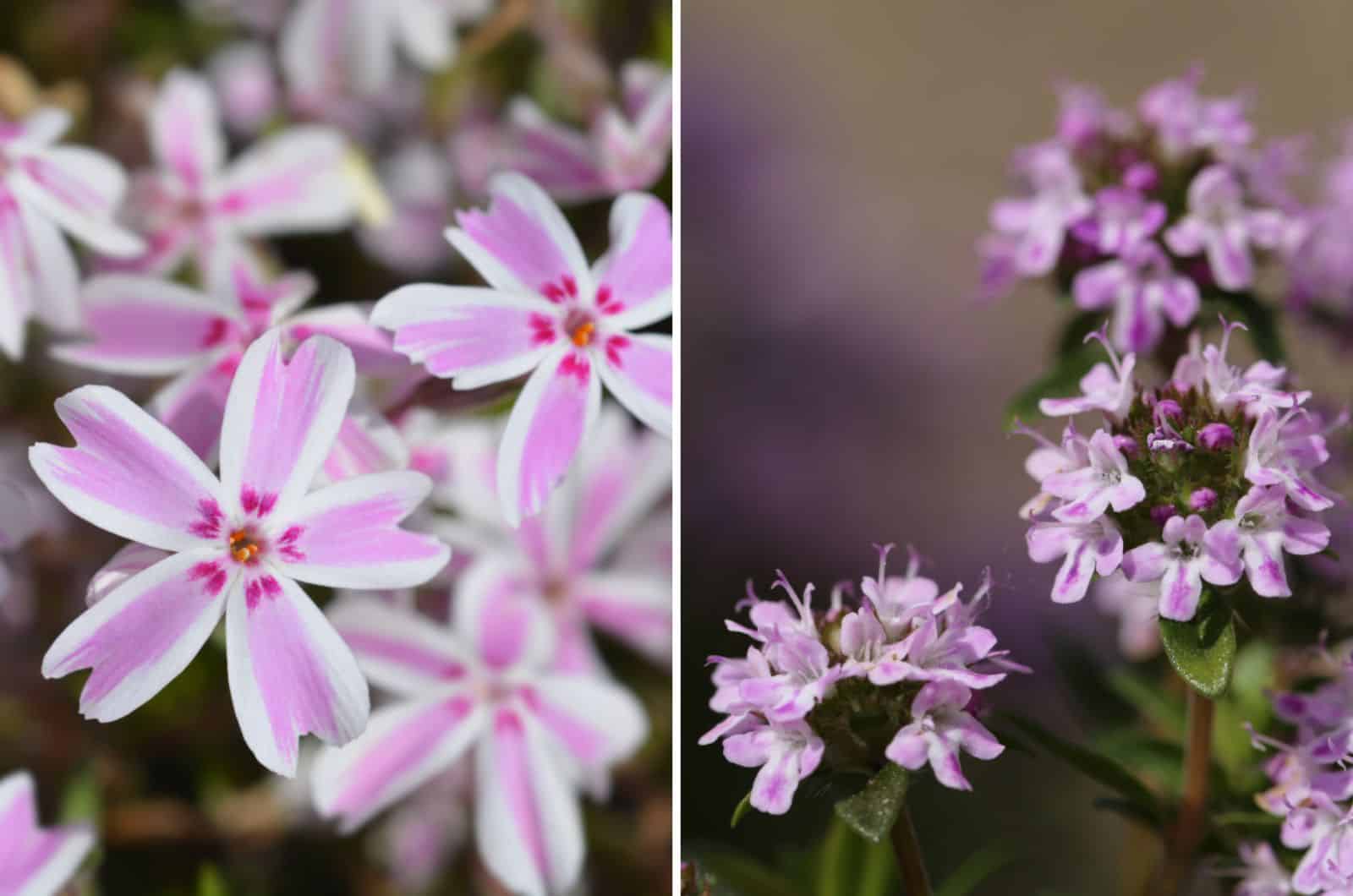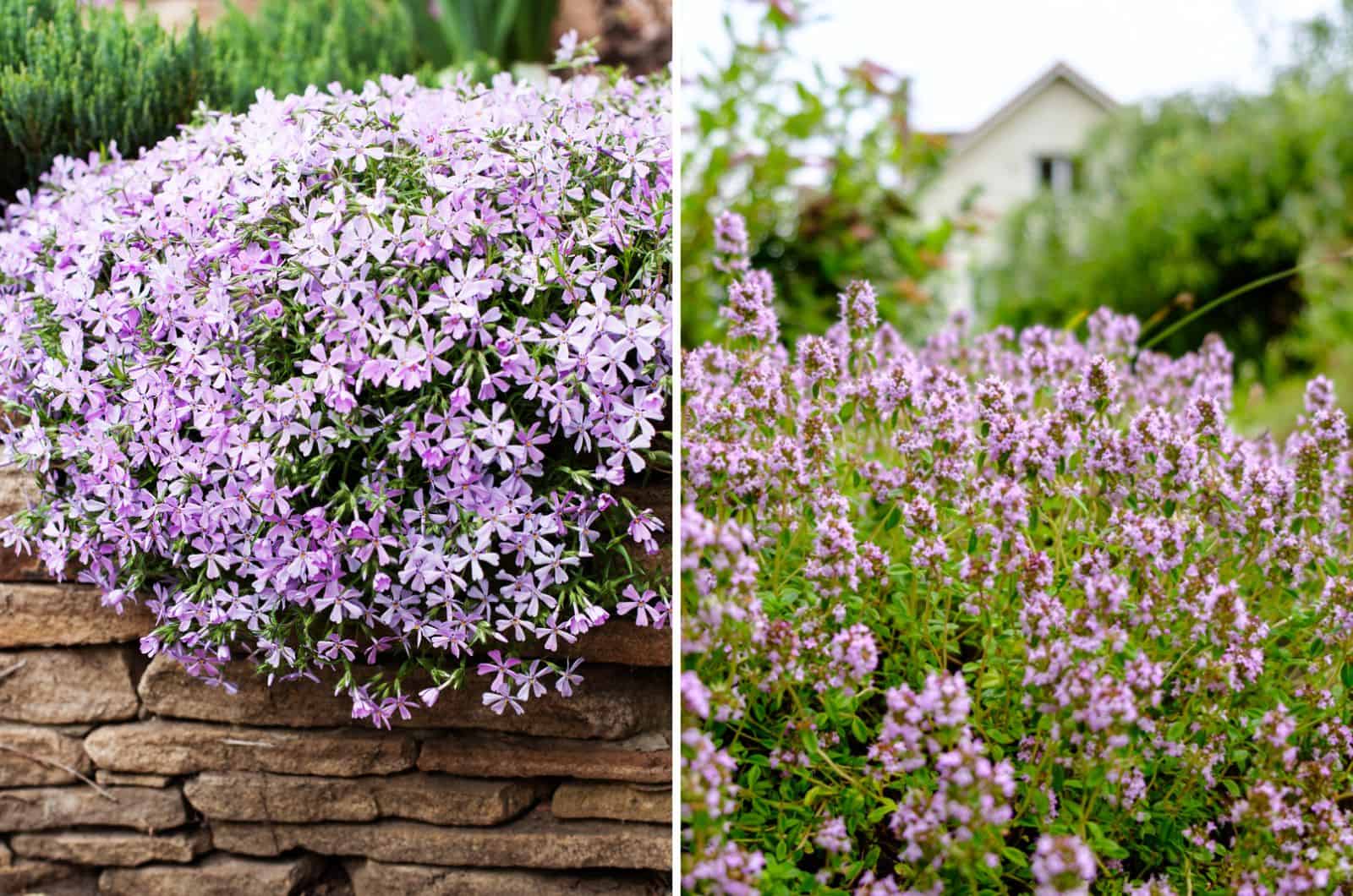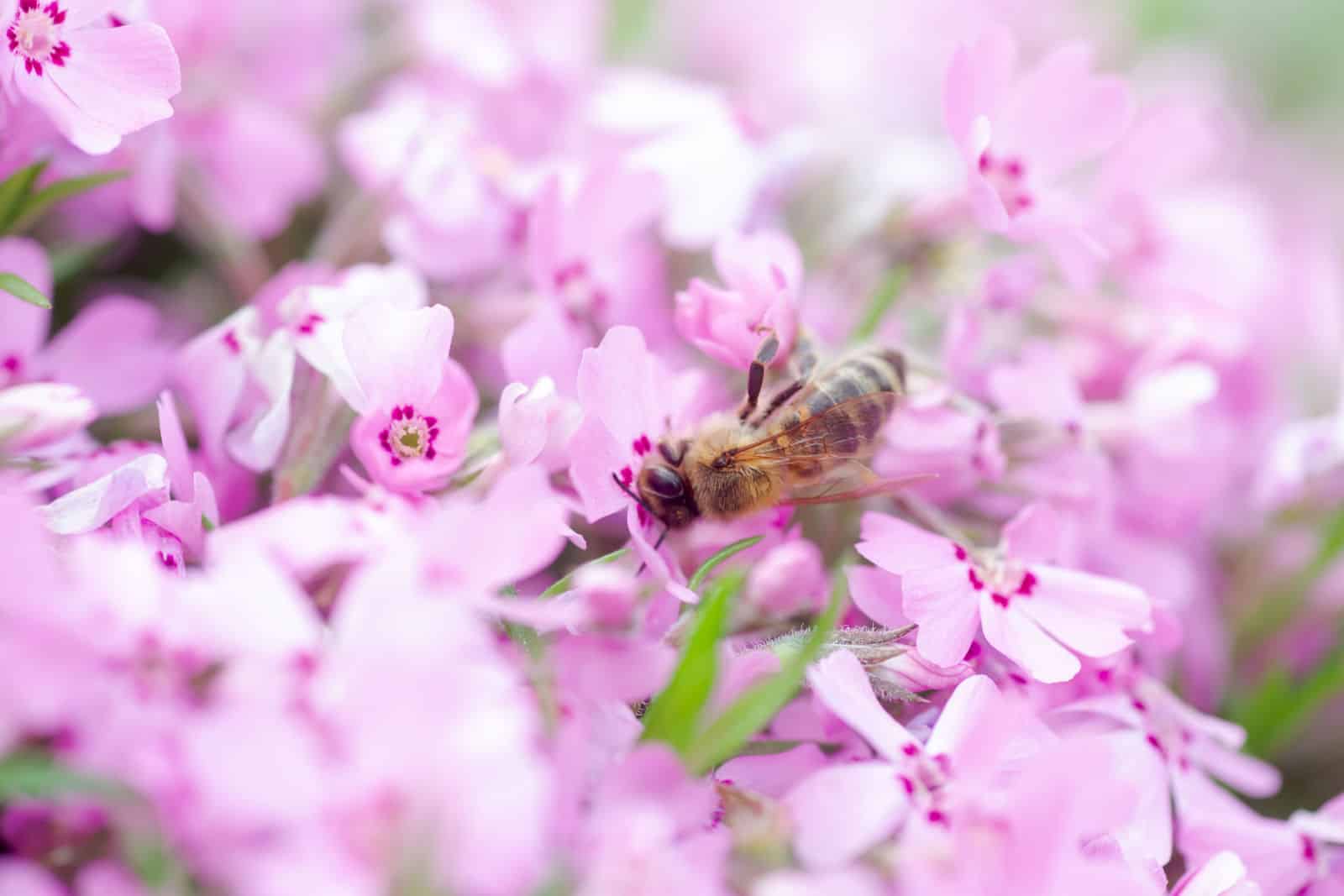If you are looking for a beautiful ground cover, Creeping phlox and Creeping thyme are great options. They are both beautiful low-growing plants that would look absolutely stunning in any garden!
However, Creeping phlox and thyme both have unique features and different requirements, and you will ultimately need to choose between them.
In this article, we are going to analyze their differences and similarities to help you choose, so keep reading to find our thorough analysis of Creeping phlox vs Creeping thyme.
Creeping Phlox vs Creeping Thyme: Main Differences
[table id=655 /]
We are going to compare Creeping thyme with two phlox varieties – Phlox subulata and Phlox stolonifera. These two phlox varieties don’t look the same, which is why it is important to mention both of them to be able to distinguish phlox from thyme.
Luckily, these plants don’t look exactly the same, which is why I’m sure that you won’t have any issue differentiating them. Apart from their appearances, the plants also differ in origin and classification.
Let’s take a closer look.
Origin
Both Phlox varieties originate from the eastern United States. However, Phlox subulata is commonly found in the rocky crevices, slopes, or sandy sites, while Phlox stolonifera is more present in stream banks and woodlands.
The P. stolonifera mostly grows from Pennsylvania south to northern Georgia.
Creeping thyme has a bit of a different origin. It originates from Asia’s Palearctic realm. The realm includes regions such as the Euro-Siberian region, the Mediterranean Basin, Sahara and Arabian desert, and regions of Western, Eastern, and Central Asia. It is usually found in dry areas such as sandy sites and rocky outcrops.
Classification
As you can see, the subulata and stolonifera varieties belong to the genus Phlox, and the Polemoniaceae family.
Creeping thyme is scientifically known as “Thymus serpyllum”. It belongs to the Thymus genus, which accounts for over 300 different species. These plants are a part of the Lamiaceae family, otherwise known as the Mint family.
In addition to their scientific names, phlox plants are often referred to as moss phlox, while Creeping thyme is also called Mother of Thyme.
Plant Type
When it comes to the plant type, these are all perennial, flowering herbaceous plants. Still, there are some differences. For instance, the P. subulata is an evergreen plant, which means that it will remain green for more than one season.
Creeping thyme is also a herbaceous perennial.
Plant Size
If you are considering growing either of these plants as a groundcover, size is one of the decisive factors.
Creeping thyme is a bit shorter than Creeping phlox – thyme grows about 2 to 3 inches tall, while phlox varieties grow about 3 to 8 inches tall. Creeping thyme is 3 to 12 inches wide, while Creeping phlox can spread about 2 feet wide.
If we go a little further and compare the sizes of the leaves and stems, we can see that Creeping phlox has leaves that are 1.2 to 1.8 inches long that grow on stems that are around 6 inches tall. The leaves of Creeping thyme are ¼ of an inch long.
Appearance
Both of these creepers are very pretty!
Creeping phlox produces clusters of flowers that are a bit larger than Creeping thyme’s flowers. They have 5 petals with colors varying between purple, pink, white, and blue, and needle-like leaves that stay green.
Creeping thyme has a few smaller flowers that also grow in clusters. The colors are usually lavender purple, pink, or white. They also have a mesmerizing fragrance. Their leaves are small and light green.
Both of these plants start flowering in spring and summer, and they continue for a few weeks. Deadheading is not necessary for them to keep producing these lovely flowers.
Propagation
Although both these creepers can be propagated using the same methods, their outcome is slightly different. For instance, Creeping phlox should be propagated by division. This way, you will get mature plants that don’t take too much time to grow and develop.
However, you shouldn’t divide the mature plant too much as it can get weaker. Propagation is best done every two to three years.
Creeping phlox can be propagated by seeds, though this is a long and troublesome process. It would be much faster if you propagated it by division. This is not the case with Creeping thyme because it is a self-seeding plant that constantly produces new plants.
You will be able to see numerous tiny plants under the mother plant. In some areas, Creeping thyme is even considered invasive.
Pests & Diseases
Sadly, both phlox and thyme are susceptible to pests and diseases.
The most common pests that invade these creeping plants are spider mites. These pests often leave silky webbing all over the plants. They are common visitors of houseplants as well, so you should check to see if there are some tiny spider eggs in the soil.
Aphids specifically infest Creeping thyme. Discolored leaves and wilting are often signs of pest infestation. Use neem oil, spray the plants with a hose, or use soapy water to get rid of them.
Creeping phlox might have to deal with foliar nematodes if the conditions are humid and wet. Brown and black damaged leaves are indicators of these critters. Since they live in the soil, it is quite hard to prevent them. Unfortunately, you will have to throw away the entire plant because at this point it can no longer be saved.
Additionally, both plants are susceptible to overwatering and root rot, though it is more severe in phlox varieties. Remember that these plants originate from dry conditions, and they prefer it that way. Yellow leaves are a sign of overwatering, though it can also mean that your plants are not receiving enough sunlight.
Creeping Phlox vs Creeping Thyme: Similarities
These two plants are not so different after all. Both can grow perfectly fine in similar growing conditions, and they can be used for similar purposes. Before planting them, take into consideration the USDA hardiness zone you live in.
Creeping phlox thrives in USDA zones 4 to 8, while Creeping thyme prefers growing in zones 5 to 9.
We are going to discuss their growing conditions in more detail, so stay tuned!
Growing Conditions
As you will see, it is quite easy to take care of these plants. Both Creeping phlox and Creeping thyme originate from hot, rocky areas, so you won’t have to worry much about soil type or sun exposure. However, you have to be careful when watering them.
Water Requirements
The issue arises with new baby plants, especially when it comes to Creeping thyme. You will have to water consistently before the plant has matured. Established and mature plants are drought-tolerant, so frequent watering won’t be necessary.
During the growing season, I suggest you water them once every ten days to allow the soil enough time to totally dry out and encourage growth.
The soil will become overly wet if you water these plants frequently, which results in overwatering. Overwatering can cause the fungal disease root rot, which can kill your plant.
Soil Requirements
Drainage is the most important thing when growing these creepers. You will have to make sure that they grow in well-draining soil since they don’t like soggy soils.
The best soil types include sand, loam, or even rocky soil. You don’t have to add nutrients, although they will grow better in nutrient-rich soil, especially Creeping phlox varieties.
Light Requirements
These plants can grow in full sun, which is why we primarily utilize them as ground covers. We mentioned above that they originate from regions where they are constantly exposed to full sun.
Choose a sunny location in your garden if you’re thinking of growing one of them as a ground cover plant. They can still flourish in partial shade, so don’t panic if your entire garden isn’t exposed to light.
Temperature & Humidity Requirements
Creeping thyme plants are not frost-hardy, so you should wait until the last frost has passed to plant them. Late spring and early summer are ideal for planting these creepers. Don’t worry, they will spread and develop quite quickly, so you won’t be left with no ground cover that season.
Both plants thrive in higher temperatures, though Creeping phlox can tolerate lower temperatures and even frost, which would be ideal if you live in a region with colder weather.
However, they are not a fan of humid environments. Although Creeping phlox can tolerate higher humidity, it prefers growing in dry conditions. Add sand or gravel around the plant’s base to prevent direct contact with wet soil.
Fertilizer Requirements
They don’t need much fertilizer, especially if the soil is well-prepared and rich in nutrients. However, I would recommend adding some, especially if you are growing phlox varieties.
Think about using slow-release fertilizer early in the growing season, which will provide the season’s worth of nutrients continuously and promote lush growth and flowers. You can also use all-purpose liquid fertilizers or garden fertilizers.
Giving your plants precisely the proper quantity of fertilizer is as simple as following the directions on the container. This is crucial since excessive fertilizer use might result in chemical build-up that can harm your plant by burning the roots.
Pruning
The good news is that once you begin growing creeping plants as a ground cover, you won’t need to bother about mowing. Pruning, however, will be a demanding task in place of mowing.
Despite the fact that these are low-growing plants, pruning your creeping plants periodically is necessary if you want them to look neat and tidy.
Cut off long shoots of Creeping thyme to keep it in shape. This plant requires constant pruning, and Creeping phlox should be pruned after blooming. Cut spent flowering stems and leggy stems, as well as discolored and damaged leaves.
Creeping Phlox & Thyme Uses
As well as ground covers, there are additional uses of these plants. For instance, Creeping thyme can be used for culinary purposes!
Because they serve as deer and rabbit deterrents, creeping thyme plants are excellent for use as border plants in your garden. They can also be grown as a single shrub.
Creeping phlox and Creeping thyme are ideal choices for rock gardens, pathways, filling out empty spaces, and stepping stones.
In addition, you should know that both of these plants are not toxic and perfectly safe to grow around your kids and pets. Although there are some types of phlox that can be mildly toxic, that is not the case with creeping phlox varieties.
Most types of thyme can be used for cooking and making tea or oils, while others are used solely for ornamental purposes.
Final Thoughts
After our thorough analysis on Creeping phlox vs Creeping thyme, I am sure that you will now easily be able to decide which plant to choose. I personally think that Creeping thyme is better because you can use it to make some delicious meals!
However, if you live in a region where it gets rather chilly, then I would definitely suggest growing Creeping phlox species since they are more tolerant to lower temperatures.
When it comes to their appearances, both plants are relatively similar. You will end up with a garden filled with beautiful purple and pink flowers. These little ones have a beautiful fragrance and they will attract a lot of beneficial insects to your garden.
You won’t mess up no matter which plant you choose!
I hope this article was helpful. Until next time!

